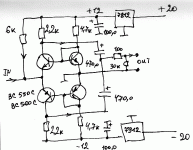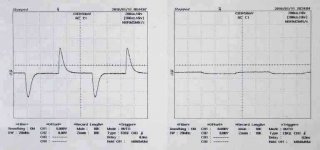...
Normally, for the TDA1541A, wen using a resistor I/V, you need your resistor to be arround 30 ohm.....
How did you come to that conclusion?
30 Ohm at TDA1541A's output will give you 60mV offset and two posts above yours you'll find the datasheet excerpt which says that 25mV is max. allowed value that ensures avoiding of performance loses...
Last edited:
How did you come to that conclusion?
30 Ohm at TDA1541A's output will give you 60mV offset and two posts above yours you'll find the datasheet excerpt which says that 25mV is max. allowed value that ensures avoiding of performance loses...
Hello
It's come from reading some threads about TDA1541 I/V resistor, lot of guys was using arround 30 ohm I/V resistor.
I remember that Thorsten's Adagio dac was using a 20 ohm I/V resistor and the last published Thorsten's circuit use a 50 ohm I/V resistor, the Lampizator uses a 100 ohm I/V resistor, but I think 100 ohm are too much.
Thank
Bye
Gaetan
Hello
It's come from reading some threads about TDA1541 I/V resistor, lot of guys was using arround 30 ohm I/V resistor.
I remember that Thorsten's Adagio dac was using a 20 ohm I/V resistor and the last published Thorsten's circuit use a 50 ohm I/V resistor, the Lampizator uses a 100 ohm I/V resistor, but I think 100 ohm are too much.
Thank
Bye
Gaetan
I remember using the I/V stage on a TDA 1541 and I didnt see any problem ,for sure was far better than the I/V resistor of 30 ohm .
Hello
There is one who was a bit similar type of I/V output in a russian forum but using BJT, I don't know how good it would be with a TDA1541, and if it's as good as the Zen I/V, but BJT are easyer to find than Jfet.
Google Traduction
Converter(2010)&ei=I_WNTMj1F8K78gaC8bivCg&sa=X&oi=translate&ct=result&resnum=4&ved=0CCgQ7gEwAw&prev=/search%3Fq%3D%2522Zen%2BI/V%2BConverter%2522%26hl%3Dfr
(look at post no. 4)
Bye
Gaetan
There is one who was a bit similar type of I/V output in a russian forum but using BJT, I don't know how good it would be with a TDA1541, and if it's as good as the Zen I/V, but BJT are easyer to find than Jfet.
Google Traduction
Converter(2010)&ei=I_WNTMj1F8K78gaC8bivCg&sa=X&oi=translate&ct=result&resnum=4&ved=0CCgQ7gEwAw&prev=/search%3Fq%3D%2522Zen%2BI/V%2BConverter%2522%26hl%3Dfr
(look at post no. 4)
Bye
Gaetan
Attachments
Last edited:
ECdesigns has made an I/V converter specific for the TDA1541A, here's the link: nos-dac-using-tda1541a
The psrr of the circuit is almost zéro, so use a great quality psu.
Gaetan,
means you'd have to do something about the 7812/7912 regulators.
Example : 7815 reg on the left, discrete voltage regulator with -124dBV output noise on the right.
Attachments
Concerning the op amps - what is the difference between the discrete op amp and IC op amp, if the last one has been designed correctly?
Not much.
The problem is most of them are not designed for specific jobs.
They are jack of all trades devices, and what makes them sell or make money for the company are the thd measurements, etc.
This usually means massive amounts of gain and massive amounts of feedback.
As diyers we don't have as much opportunity to use our brain when using opamps, this eventually leads to boredom.
It might be a different story if you are a design engineer for Analog Devices or National Semiconductor. If I was offered a job by either of those two companies I would be excited, because it would be an opportunity to learn quite a lot.
I think it is all about having complete control over the design process when you use discretes, which is something I find lacking if I resort to IC's.
When I first started this hobby, my motivation was to be able to build something I couldn't afford to buy in the shop.
Now it is all about trying to understand how everything works, and building my own circuits. I think that is also true for a lot of other Pass fans.
Last edited:
[snip]Now it is all about trying to understand how everything works, and building my own circuits. I think that is also true for a lot of other Pass fans.
Hear! Hear! That's the best reason I know for audio diy.
I think it is true for a lot of audio diy-ers, period!
jan didden
Hi Gaetan,
There is a lot of problems with this stage:
- You use a voltage source input. Should be a current source with offset=2mA, amplitude=2mA to simulate a tda1541
- the bias current is way too low. Should be around 10mA at least to correctly handle +/-2mA swing.
- the input supply should be stable if you want to use the 6k resistor as a current source. If it is not, use a current source with a jfet.
- the rails are too low to have 10mA at idle in the output resistor R1/R4.
I've made some simple modifications to make it run:
- set the source to current type
- supply with +/- 24v
- bias resistor at input 3k
it simulates ok then
There is a lot of problems with this stage:
- You use a voltage source input. Should be a current source with offset=2mA, amplitude=2mA to simulate a tda1541
- the bias current is way too low. Should be around 10mA at least to correctly handle +/-2mA swing.
- the input supply should be stable if you want to use the 6k resistor as a current source. If it is not, use a current source with a jfet.
- the rails are too low to have 10mA at idle in the output resistor R1/R4.
I've made some simple modifications to make it run:
- set the source to current type
- supply with +/- 24v
- bias resistor at input 3k
it simulates ok then
....There is a lot of problems with this stage:...
Just to make sure that everyone understands clearly - there are no problems with the I/V stage from post #106 (it works nicely, with 8.5mA through input pair and PS of +/-24V instead of +/-12V, Zin=2.5 Ohms).
The only problem is the way the Gaetan simulated it
Let's not hijack this thread further - guys with interest in BJT stage from post #106 can open separate thread.
Hello apolon34
I've use the circuit from post 106 without mods, but I've forgot to give a sine current source.
After using your suggestions it's now working and thd spectrum simulation give a -80 db thd for the second hamonic.
Here is the new sim file in text version.
Thank you
Bye
Gaetan
I've use the circuit from post 106 without mods, but I've forgot to give a sine current source.
After using your suggestions it's now working and thd spectrum simulation give a -80 db thd for the second hamonic.
Here is the new sim file in text version.
Thank you
Bye
Gaetan
Attachments
Last edited:
Just to make sure that everyone understands clearly - there are no problems with the I/V stage from post #106 (it works nicely, with 8.5mA through input pair and PS of +/-24V instead of +/-12V, Zin=2.5 Ohms).
The only problem is the way the Gaetan simulated it(apolon34 described the errors).
Let's not hijack this thread further - guys with interest in BJT stage from post #106 can open separate thread.
Hello
Sorry, it was not my intention to hijack this thread.
Back to the NP jfet version, the only 2SK170 here arround are a cheap chineese V version, and no 2SJ74
Does the original NP jfet version are much better than the russian bjt version ?
If yes, I will look for good jfet and built the NP Zen I/V
Thank you
Bye
Gaetan
Last edited:
Hello
Sorry, it was not my intention to hijack this thread.
Back to the NP jfet version, the only 2SK170 here arround are a cheap chineese V version, and no 2SJ74
Does the original NP jfet version are much better than the russian bjt version ?
If yes, I will look for good jfet and built the NP Zen I/V
Thank you
Bye
Gaetan
Sonically, the jfet version might sound better than the bjt one;
it's not the overall design that achieves this,
but mostly the nature of the devices themselves
- Home
- Amplifiers
- Pass Labs
- Zen I/V Converter


